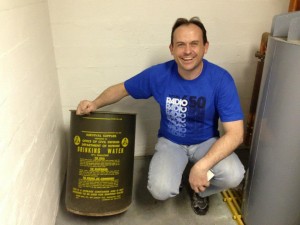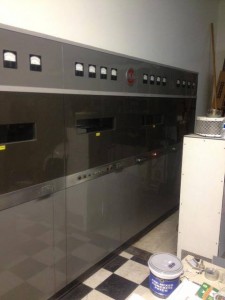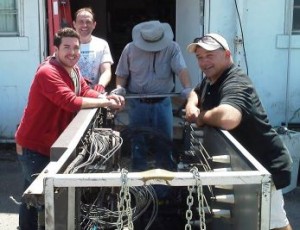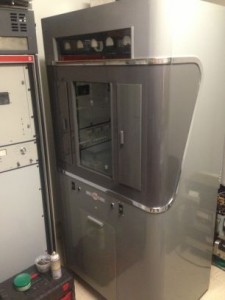We humans love our machines. We polish and parade our cars. We line up hours ahead to buy a new smartphone, tablet computer, or video game processor.

Scottie Rice, staff engineer at KFMB AM and FM, gives homes to elderly AM radio transmitters.
His latest project was moving the RCA BTA-5F 5kW transmitter from KOGO, and I’ll let him pick up the story from here. Note that like a captain describing his ship at sea, Scottie refers to his inheritance as “she.”
The RCA was installed at Emerald Hill in 1948, when the transmitter site moved from the U.S. Grant (1925-1948). Leroy Belwood Junior and Ralph Evans, longtime KFSD [later KOGO] engineers, installed her. She ran full time from 1948-1980 when she went into backup service. The last time she ran as KOGO was 1997, when the Collins/Rockwell Power Rock couldn’t stay on the air. She ran for one week until a brand new Gates 5 showed up then she was shut off. In 2013 before I started dismantling her we powered her filaments up to see the beautiful 892R’s glow one more time at KOGO.

There were hundreds of these transmitters sold by RCA, due to the self-financing that RCA offered to radio stations. As of today, there are only 3 COMPLETE surviving BTA-5F’s still in existence (KOGO, KRKD, KIIS, and WIBW). In San Diego itself both KCBQ and KFSD/KOGO had these transmitters. When Jay Brentlinger (now owner of CRL and Orban) took over as CE of KCBQ, he took a tractor and a chain and drug the KCBQ BTA-5F out into the middle of the field. Once out there John Rigg and Bill Thompson pulled parts out of her to keep the KOGO RCA alive.
Back in 2010 Clear Channel donated most of its vintage tube transmitters to the Rasmus auctions. If no one had bid on the KOGO transmitter she would have to have been rippped out by Rasmus. So I decided to bid the token $100. Not to my surprise I won. I think I was the only one crazy enough to spend money on such a thing. Thanks to [Clear Channel local market Director of Engineering] John Rigg, he allowed me to take my time removing her so that she could go back together and one day live again. I am doing this to try to save this beautiful historic transmitter and someday find a museum for her to go in.
The RCA BTA-5F was the first post war transmitter that was designed by RCA (all others were re-badged and repainted pre-war boxes). The 5F’s looks were designed by industrial art deco designer John Vassos. Vassos is considered to be one of the fathers of art deco in the United States. Among Vassos’ designs are the first RCA tv sets (TRK series), RCA’s first tv cameras (namely the TK-11), RCA’s first color TV model CT-100, all of the RCA tranmitters, and RCA 77D/DX microphone. All of the beauty that RCA broadcast products had was due to John Vassos. Vassos loved the BTA-5F, and called her “The Train” as he designed her to look like a train speeding by.
Where is the BTA-5F now?
Most of the BTA-5F is in a storage facility in Kearny Mesa that I am paying for so that I can preserve her until a museum comes along.
You don’t have a museum home lined up for it?
No museum has stepped up yet for her, but if not eventually being at KFMB, I can get a house and she will have a home there.
Who helped move it with you?

The people that helped with the move have been Gilbert Smith (of ITV), Jeff Latimer (of XETV), John Rigg (of CC), Steve Smith, Gene Knight (of XHRM who gave me my first job in radio!), Eric Rubalcava (of 760 KFMB), and of course Bill Thompson Chief Engineer of KOGO.
Do you have other old broadcast gear? Transmitters?
Well, over the last almost 20 years I have saved about 30 transmitters from being destroyed. Most of them were 1kw AM boxes that I got into the hands of loving hams that have moved them to 3.870 [MHz on the 75 meter ham radio band where AM operators still hang out]. One of the Collins 20V-3’s I saved is the main transmitter of the legendary Mike Dorrough (KO6NM), maker of the Dorrough DAP audio processors and meters.

I currently have at my house five transmitters: A Collins 20V that I completely restored after it had been destroyed, Collins 820-D2, Collins 831-D2, Collins 32V-3, and a Harris FM20K. I have one of nearly every model of RCA microphone. I have a complete and functional PR&E studio with a PR&E ABX-26. I also have an RCA BC-7A (from KIIS-FM), Gates CC-1 dual channel TV console (only 4 known to exist), and a Gates Studioette. There are also 3 other misc PR&E consoles in the house, and many antique radios and TV’s, including the RCA CT-100 first color TV set. I love boatanchor receivers, and have a Collins 75A-4, Hallicrafters SX-28 (from the late legendary engineer John Morgan), Hallicrafters S-36-A, Hallicrafters SX-42, and the ultimate tube receiver the RCA CR-91A (only 5-6 are known to exist).
Why do you do this?
I have been collecting old radios and gear since I was 12 years old, and found that most broadcasters were just trashing our radio and television history as quickly as possible. I felt it my responsibility to save our American history, without the transmitters, mics and boards the people that we call legends could not have ever been on the air. Without the KOGO RCA BTA-5F, Ernie Myers would not have gone to the race track, Larry Boyer would not have been a dj or news man and conceived Chris Boyer in the back of a KOGO news van, and Shotgun Tom as a boy would not have gone to the KOGO remote truck to see Frank Thompson, and inspired him to be our city’s greatest legend. Other people collect the mics and even the boards, and others tell the story of KCBQ, KGB, and KDEO, but I love the history of our biggest historical station, KFSD/KOGO San Diego’s first commercial broadcast station. I realized 6 years ago that no one had ever cared or taken the time to compile a history of KOGO, so I did, but I added a little bit of a bias to the RCA transmitter. The first transmitter I ever saw in my career was the KOGO BTA-5F, to me that was radio, and is what a transmitter is supposed to look and sound like. I highly encourage more people to collect transmitters and broadcast gear as it is very satisfying to know that you have saved a piece of irreplaceable history that made a difference in the city that it served.
It breaks my heart that the big conglomerates don’t care about the history of these great stations, and destroy everything that made that history. The BTA-5F was at KOGO from 1948-2014. Had she been kept she could have still been running, and an amazing display piece to show the greatness of the station. The KOGO BTA-5F is one of only 2 that are still complete and able to be made to run. KCBQ had one and it was destroyed. KFMB had a BTA-5G, and it was destroyed. The BTA-5F at KOGO was the oldest transmitter in its original install in Southern California.
Now, like our radio history, she is gone too.
